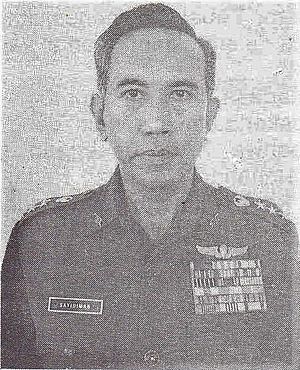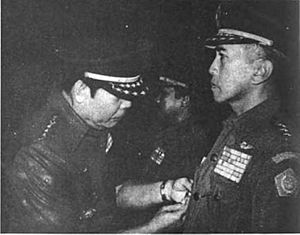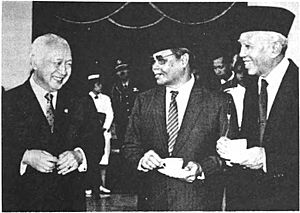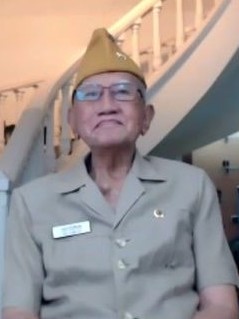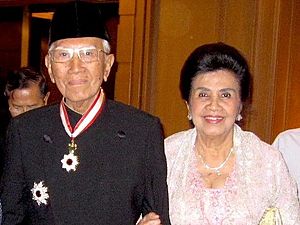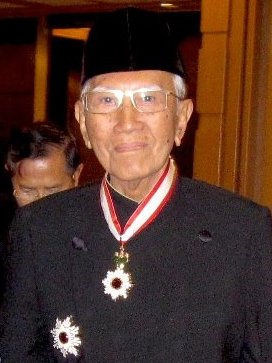Sayidiman Suryohadiprojo facts for kids
Quick facts for kids
Sayidiman Suryohadiprojo
|
|
|---|---|
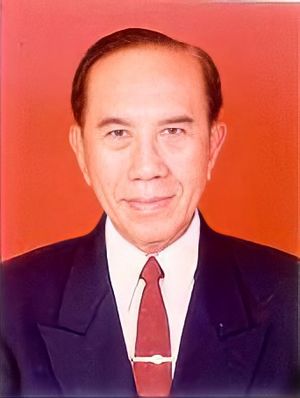 |
|
| Member of the People's Consultative Assembly | |
| In office 1 July 1998 – 1 October 1999 |
|
| President | B. J. Habibie |
| Indonesian Ambassador at-large to Africa | |
| In office 14 November 1992 – 20 October 1995 |
|
| President | Suharto |
| Preceded by | Office established |
| Succeeded by | Office dissolved |
| Indonesian Ambassador to Japan | |
| In office 23 June 1979 – 31 August 1983 |
|
| President | Suharto |
| Preceded by | A. J. Witono |
| Succeeded by | Wiyogo Atmodarminto |
| Personal details | |
| Born |
Sayidiman
21 September 1927 Bojonegoro, East Java, Dutch East Indies |
| Died | 16 January 2021 (aged 93) Gatot Soebroto Army Hospital, Jakarta, Indonesia |
| Spouses |
Sri Suharyati Djatioetomo
(m. 1958; died 1994)Harpini Winastuti Kadarisman
(m. 1996) |
| Parents | Bawadiman Kartohadiprodjo Oemi Oentari Kartohadiprodjo |
| Military service | |
| Allegiance | |
| Branch/service | |
| Years of service | 1945—1982 |
| Rank | |
| Battles/wars | Indonesian National Revolution |
Sayidiman Suryohadiprojo (born September 21, 1927 – died January 16, 2021) was an important Indonesian military officer and diplomat. He held many key roles during his life. These included being the Deputy Chief of Staff of the Indonesian Army, Ambassador to Japan, and Ambassador-at-large to Africa.
Contents
Early Life and Education
Sayidiman was born in Bojonegoro, East Java, on September 21, 1927. His parents were Bawadiman Kartohadiprodjo and Umi Untari Kartohadiprodjo. Sayidiman's father was a local leader (Regent) in Pasuruan. Sadly, his father passed away when Sayidiman was only six years old. Like many Javanese at that time, he was born with just one name, Sayidiman. He was the sixth of seven children in a Muslim family.
He went to the Europeesche Lagere School (a European Primary School) from 1932 to 1939. After that, he continued his studies at the Hogere Burgerschool (Higher Civic School) and other high schools until 1945.
Military Career
Joining the Army
After Indonesia declared its independence, Sayidiman joined the Indonesian Military Academy in Jogjakarta. This academy had just opened in October 1945. Sayidiman was one of 441 cadets accepted into the new academy.
In September 1948, after his final exams, Sayidiman was sent to Surakarta. He helped to stop a conflict known as the Madiun Affair. He led a platoon of soldiers. After the conflict ended in October 1948, he prepared for his graduation.
Sayidiman graduated on November 28, 1948, as a second lieutenant. He was one of the top three graduates. This allowed him to choose where he would serve. He chose the Siliwangi Division because he had already gained experience there.
Key Deployments
Soon after he graduated, the Dutch military launched an attack called Operation Kraai. Sayidiman returned to lead his platoon. In December 1949, he was put in charge of a company of soldiers. After a peace treaty was signed, he was promoted to first lieutenant in April 1950. He then fought against the Darul Islam rebels.
In 1951, Sayidiman was sent to the United States Army Infantry School. After finishing in 1953, he returned to Indonesia. He studied economics at Padjadjaran University and also taught at the Infantry Training Center. He became a captain in July 1954. He left the university in 1956 to become a teaching officer at the National Military Academy.
Sayidiman later became the Commander of the 309th Battalion. He was promoted to lieutenant colonel. His battalion was sent to North Sumatra to fight against the Revolutionary Government of the Republic of Indonesia (PRRI). They arrived in Sibolga in October 1958 and successfully took over several villages. They also set up military posts and connected with other battalions.
Roles in the Military Academy and Headquarters
After his time in North Sumatra, Sayidiman was promoted to major. He returned to the Indonesian Military Academy. There, he served as a deputy commander for the cadet corps. He also held other important roles, like acting director of the academy.
In January 1962, Sayidiman was transferred to Jakarta to work at the Indonesian Army Headquarters. He handled organizational matters. In 1964, he studied at the Bundeswehr Command and Staff College in Germany. He became a colonel in 1965. In November 1966, he was promoted to Brigadier General. He became the Deputy to the Assistant II (Operations) of the Chief of Staff.
Commander of Hasanuddin Military Region
On August 3, 1968, Sayidiman became the Commander of the Hasanuddin Military Region. This role meant he was in charge of military operations in that area. He led an operation called "Operation Lighting" to deal with rebel groups. This operation led to the capture of some key figures. He finished his command in March 1970.
Joint Chairman for Personnel Affairs
In January 1970, Sayidiman was appointed as the Joint Chairman for Personnel Affairs for all armed forces. This was his first role that connected all four branches of the military. He worked on making military insignias (badges and symbols) uniform across all branches. This project started in 1971 and the new insignias were introduced in 1973.
Deputy Chief of Staff of the Indonesian Army
On March 26, 1973, Sayidiman became the Deputy Chief of Staff of the Indonesian Army. This was the second-highest position in the army. His appointment was seen as a way to bring in a new generation of leaders. The army chief of staff, Umar Wirahadikusumah, said Sayidiman would lead this change.
Sayidiman traveled a lot in this role. He visited places like Irian Jaya (now Papua) and South Sulawesi. He also went to Japan in October 1973. He was promoted to Lieutenant General on December 1, 1973.
However, his time as deputy chief of staff was short. He was removed from his position on June 12, 1974. This decision came directly from President Suharto. Sayidiman was surprised and confused by this. Later, he learned that Suharto might have been misinformed about his relationships with certain groups.
Civilian Roles
Governor of the National Resilience Institute
Just three days after leaving the army, Sayidiman was appointed as the Governor of the National Resilience Institute. He held this position for five years until November 1978. He also served briefly as a member of the People's Consultative Assembly from 1977 to 1978.
Ambassador to Japan
Sayidiman became the Indonesian Ambassador to Japan on June 23, 1979. He presented his official papers to Hirohito on July 20. He served as ambassador for six years, until August 31, 1983.
As ambassador, Sayidiman worked to share Indonesian culture with the Japanese people. The embassy started Indonesian language courses, which are still held today. He also organized an exhibition of artifacts from Borobudur, which was very popular.
He also wrote the first book about Japan in the Indonesian language. It was called Japanese People and Society in the Struggle for Life. This book looked at the strengths and weaknesses of Japanese society. He officially retired from the military in October 1982.
Ambassador-at-large to Africa
In 1992, President Suharto became the chairman of the Non-Aligned Movement. To help with this, he appointed four special ambassadors. Sayidiman was chosen as Indonesia's ambassador-at-large to Africa on November 14, 1992. In 1993, he observed the Eritrean independence referendum, where people voted for independence. This special ambassador role ended in October 1995.
Later Life and Passing
In his later years, Sayidiman became more open about his views on leadership. After President Suharto resigned in 1998, B. J. Habibie became president. Habibie began many political changes. Sayidiman supported these changes. He was appointed to the People's Consultative Assembly on July 1, 1998, serving for over a year. He also advised the National Reformation Team and the National Education Advisory Board.
Sayidiman passed away on January 16, 2021, at 4:15 PM, in the Gatot Soebroto Army Hospital in Jakarta.
Personal Life
Sayidiman married Sri Suharyati Djatioetomo on July 6, 1958. She was the daughter of a police general. Following Javanese custom, Sayidiman chose the last name Suryohadiprojo after marriage. They had five children: Adwin Haryanto, Laksmi Adriyani, Umi Riyanti, Adri Sarosa, and Diana Lestari. Sadly, Sri Suharyati passed away on June 1, 1994, after a long illness. Sayidiman later married Harpini Winastuti Kadarisman on January 6, 1996.
Writings
Sayidiman was known for his many books and articles. His first book was a translation of Infantry Tactics and Techniques in 1954. He then wrote his own book, Problems of National Defence, in 1964. Between 1970 and 2019, he wrote fourteen more books, including his autobiography in 1997.
Some of his notable books include:
- Tactics and Technique of Infantry (1954)
- Problems of National Defense (1964)
- Learning from Japan: Japan's Man and Society in Life Struggle (1982)
- Facing the Challenges of the Future (1987)
- Serving the Nation as an Armed Forces Soldier: An Autobiography (1997)
- Building a Modern and Effective National Defence (2005)
- Introduction to Warfare Science (2008)
Legacy
Sayidiman's love for writing earned him the nickname "The Thinking General." He was often compared to other smart military leaders. Many people admired his continuous learning and development. Suryo Prabowo, a former chief of staff, called Sayidiman a "complete professional soldier, diplomat, thinker, and educator."
Awards
Sayidiman Suryohadiprojo received many awards for his service:
* ![]() Star of Mahaputera, 3rd Class *
Star of Mahaputera, 3rd Class * ![]() Military Distinguished Service Star *
Military Distinguished Service Star * ![]() Guerrilla Star *
Guerrilla Star * ![]() Star of Yudha Dharma, 2nd Class *
Star of Yudha Dharma, 2nd Class * ![]() Star of Kartika Eka Paksi, 2nd Class *
Star of Kartika Eka Paksi, 2nd Class * ![]() Star of Kartika Eka Paksi, 3rd Class *
Star of Kartika Eka Paksi, 3rd Class * ![]() Star of Jalasena, 3rd Class *
Star of Jalasena, 3rd Class * ![]() Star of Swa Bhuwana Paksa, 3rd Class *
Star of Swa Bhuwana Paksa, 3rd Class * ![]() Star of Bhayangkara, 2nd Class *
Star of Bhayangkara, 2nd Class * ![]() Military Long Service Medals, 2nd Category * Independence War Medal I and II * Military Operational Service Medals I, V, and VI
Military Long Service Medals, 2nd Category * Independence War Medal I and II * Military Operational Service Medals I, V, and VI
* ![]() Order of the Rising Sun, Gold And Silver Star
Order of the Rising Sun, Gold And Silver Star
Military Ranks
| Officer cadet | 24 November 1945 | |
| Second lieutenant | 28 November 1948 | |
| First lieutenant | 12 April 1950 | |
| Captain | 1 July 1954 | |
| Major | 1 July 1960 | |
| Lieutenant colonel | 1 July 1962 | |
| Colonel | 1 July 1965 | |
| Brigadier general | 1 November 1966 | |
| Major general | 1 October 1970 | |
| Lieutenant general | 1 December 1973 |
Images for kids


